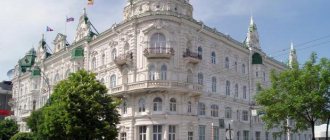General information and history
Taganrog is located in the Rostov region, on the Taganrog Bay of the Azov Sea, 70 km from Rostov-on-Don. Included in the list of historical cities of the Russian Federation.
In the fall of 2011, Taganrog received the title of “City of Military Glory.”
COVID-19. What is known about the breakthrough drug molnupiravir? Go to article
In the 7-6 centuries BC, on the site of Taganrog there was an ancient Greek settlement, most likely called Kremny.
In the 12th century, the Italians founded the port city of Porto Pisan on this site.
The founder of Taganrog in 1698 was Peter I. The city became the first Russian port on the open sea coast, the first city built according to a regular plan and the first naval base in the Russian Empire.
When Sevastopol was built, Taganrog lost its military-strategic significance, but instead became the largest trading port in the empire. Consulates of fifteen foreign countries began to function there.
In 1918, the Bolshevik government of the Ukrainian Soviet Republic moved to Taganrog from Ekaterinoslav (Dnepropetrovsk). Taganrog was part of the Donetsk province of the Ukrainian SSR from 1920 to 1924, after which it became part of the RSFSR.
The occupation of Taganrog during the Great Patriotic War lasted from October 17, 1941 to August 30, 1943.
Taganrog city
Symbolism
| Flag | Coat of arms |
Anthem of Taganrog
Administration
347900, Taganrog, st. Petrovskaya, 73
Phone +7 (8634) 312-800, fax +7 (8634) 312-730
Housing and communal services hotline
Official site
www.tagancity.ru
Head of the Taganrog city administration
Solonitsin Mikhail Vladimirovich
Geography
Taganrog is the second largest city in the Rostov region, located on the northern coast of the Taganrog Bay of the Sea of Azov.
The distance from the mouth of the Don River, on the one hand, and from the border with Ukraine, on the other hand, is about 50 km, the distance from Moscow is 950 km, from Rostov-on-Don - 60 km. The area of the city is 85 square meters. km, population – more than 248.7 thousand people.
Story
Taganrog was founded in 1698 by Peter I and became Russia's first naval base. The further development of the city was closely connected with the names of Catherine II, Alexander I and other famous statesmen who had a noticeable influence on its formation and development.
After the annexation of Crimea to Russia, Taganrog from a fortified city became a rich port city, which played a leading role in Russian trade in the southern direction.
Since the end of the 19th century, a number of large industrial enterprises have been created in the city, including those with the participation of foreign capital. Then, in the 20-30s of the 20th century, the industrial base of the city was significantly expanded.
During the Great Patriotic War, Taganrog was occupied for almost two years. The largest underground organization in the south of the country operated in the city; G. Hoffmann’s book “Heroes of Taganrog” is dedicated to the fight against the fascists. With the liberation of Taganrog on August 30, 1943, the complete liberation of the Rostov region from the Nazi invaders was completed.
Taganrog - City of military glory. This honorary title was awarded to Taganrog for the courage, resilience and mass heroism shown by the city’s defenders in the struggle for freedom and independence of the Fatherland by Decree of the President of the Russian Federation of November 3, 2011 No. 1459.
After the war, the restoration of the urban economy proceeded at a rapid pace. In the 60-90s, in addition to industry, the social, cultural spheres, and the communication network received significant development.
Economy
Taganrog is a large industrial, scientific, cultural and historical center, one of the leading seaports on the southern borders of Russia.
On its territory there are: 2 passenger and 2 freight railway stations, a sea trade port, 2 runways, 2 bus stations for suburban and intercity traffic.
There are more than 4,100 small enterprises, organizations of all forms of ownership, 268 large and medium-sized enterprises, organizations and branches, and about 8,300 individual entrepreneurs operating in the city.
The city-forming and system-forming enterprises are: PJSC Taganrog Metallurgical Plant, PJSC Taganrog Boiler-Making Plant, PJSC Taganrog Aviation Scientific and Technical Complex named after. G.M. Beriev", JSC "Red Hydropress", JSC "Taganrogsky", JSC "TNIIS", LLC "Khlebzernoprodukt", LLC "Karavai Yug", JSC "Famadar Kartona Limited", JSC "PromTyazhMash" and others.
The city has a fairly well-developed tourism infrastructure, which includes: 42 hotels and other accommodation facilities in the mid-price segment with 955 rooms and 1,907 places for one-time accommodation.
Culture
Taganrog is known in Russia and far beyond its borders as the birthplace of many outstanding people. The artist K. Savitsky and the architect J. Rubanchik were born here; actress F. Ranevskaya and the “pioneer” of Soviet jazz V. Parnakh; designer L. Gobyato and poetess S. Parnok; writer I. Vasilenko and poet M. Tanich; historian A. Lakier and director I. Perestiani.
The names of the revolutionary P.P. are also associated with the city. Schmidt, artist A.K. Kuindzhi, writer K.G. Paustovsky, trainer A.A. Durov, singer E.V. Obraztsova, aircraft designers G.M. Berieva, R.L. Bartini and V.M. Petlyakov, writer and public figure N.V. Kukolnik, surgeon N.A. Bogoraz and many others.
Taganrog is the birthplace of the great Russian writer Anton Pavlovich Chekhov. The presence of Chekhov is still felt in the city, where everything connected with the memory of the brilliant countryman is carefully preserved - the house where the writer was born, the shop of his father, who traded in colonial goods, the gymnasium, where the exposition of the literary museum is now located, the theater that now houses it name, the public library he helped create.
The network of municipal cultural institutions consists of 19 institutions whose activities are aimed at providing additional education for children, cultural and leisure activities, and library services to the population.
A charity event “Under the Flag of Good!” is held annually in Taganrog. The main goal of this campaign is targeted assistance to children in need of expensive treatment.
Taganrog is rightly called an open-air museum city; Many ancient mansions, architectural and historical monuments have been preserved here, including the Stone Staircase, the Palace of Alexander I, the building of the city theater, the Alferaki Palace, St. Nicholas and All Saints churches, monuments to Peter I and A.P. Chekhov.
Attractions
Sights of the city of Taganrog
Districts of Taganrog
During the Soviet era, there were three districts in Taganrog: Oktyabrsky, Leninsky and Ordzhonikidzevsky. Currently, the city is divided into five territorial departments (districts): Primorskoe, Western, Central, Northern and Industrial.
It also includes such districts and microdistricts as: Bogudonia, Military Town, Zhidilovka, Western Microdistrict, Kasperovka, Mikhailovka, New Houses, New Station, PMK, Prostokvashino, Russkoye Pole, Northern Village / SZhM, Sobachevka, and Center.
Details of the program and financing procedure are not yet ready
As the city administration told Expert YUG, the road map for the integrated development of Taganrog is now “in the process of updating.” It is not reported who is developing and updating this project. The volume of financing for events until 2023 is more than 21.6 billion rubles. In 2022, Russia celebrates the 350th anniversary of the birth of Peter I. Taganrog, which he founded, is also included in the celebration program. In honor of this event, Taganrog promises to overhaul the facades of 230 houses. Half of them are cultural heritage sites. Construction work is also underway on the city's road transport system.
By 2023, the ongoing reconstruction of the tram network should be completely completed. Active work has already begun: its cost is estimated at 11.8 billion rubles, according to the concession agreement concluded between the city administration, as well as the Sinara group (controlled by Tagmet) and the state. This project, by the way, will become the largest in the field of public-private partnership in the South.
Related article:
In cities with a population of over a million, a metro will be completed or a metrotram will be built
Population of Taganrog for 2021 and 2021. Number of residents of Taganrog
Data on the number of city residents are taken from the Federal State Statistics Service. The official website of the Rosstat service is www.gks.ru. The data was also taken from the unified interdepartmental information and statistical system, the official website of EMISS www.fedstat.ru. The website publishes data on the number of residents of Taganrog. The table shows the distribution of the number of residents of Taganrog by year; the graph below shows the demographic trend in different years.
Links to official documents and resources on the population census are marked with a [*] sign; when you hover your mouse, you will see the title of the document.
| Number of residents of Taganrog | Years |
| 273,000 people | 2005 year |
| 268,600 people | 2006 |
| 264,400 people | 2007 |
| 260,700 people | 2008 |
| 257,611 people | year 2009 |
| 257,681 people | 2010 |
| 257,221 people | 2011 |
| 256,565 people | year 2012 |
| 254,783 people | year 2013 |
| 253,587 people | year 2014 |
| 253,040 people | 2015 |
| 251,050 people | 2016 |
| 250,287 people | 2017 |
Graph of population changes in Taganrog:
In terms of population (253,587 people, as of 2014), Taganrog ranks 75th among the cities of the Russian Federation. Of this number, the majority are occupied by women. The agglomeration is inhabited by over 325 thousand people. The density is 3169.84 people/km². Ethnic names are Taganrozhtsy, Taganrozhets, and Taganrozhenka. Taganrog is inhabited by representatives of approximately one hundred nations. The largest diasporas are Armenian, Jewish and Greek.
The “reset” of Taganrog began with the visit of the Speaker of the Federation Council
The starting point for creating the “road map” can be considered the visit of Federation Council Chairman Valentin Matvienko to the Rostov region in September last year. Then she visited the Sambek Heights memorial complex, as well as Taganrog itself, noting the high tourism potential of the city and region. The speaker promised that she would provide budget support to develop tourism there.
“Taganrog is Peter’s city, and she was the governor of St. Petersburg...”, Don Governor Vasily Golubev explained the motives of the federal official on the air of the regional TV channel Don24.
At the same time, according to Deputy Governor Alexander Scriabin, with the support of the head of the region, the city administration took the initiative to develop a set of measures for the development of Taganrog as a tourist center. In terms of tourism development, a comprehensive balneological study of the territory, classification of the beaches of the sea coast, and installation of tourist navigation signs were planned. The project also included the holding of events that have become the hallmark of the city: the “Defense of Taganrog 1855” and “Umbrella Morning” festivals, the Chekhov regatta “The Seagull”, the Chekhov Theater Festival. The creation of an exposition of the local history museum (Alferaki Palace) and activities to promote the city within the framework of the tourist brand of the “Free Don” region were also noted.
However, this was a list of far from the most financially intensive events. Much more large-scale work includes the reconstruction of roads, improvement of popular city locations, and development of a hotel complex. The organization of regular passenger transport by water transport between tourist centers not only in the region, but also in the south of Russia was also considered. All this should attract more tourists to the city. However, specific targets were never presented.
The only attempt to attract the public to such a large-scale project was that until February 14, a call for proposals from Taganrozh residents was announced. More than 300 messages were sent to the city administration's email address. Then all of them were analyzed and structured by the administration staff. As a result, until 2023, they planned activities “with a confirmed budget” to organize festivals, modernize the track and power grid, update the rolling stock of city electric transport, repair and restoration of facades and roofs of historical buildings, and modernize the water supply and sewerage system. In the longer term, it is planned to modernize the lines of outdoor lighting networks, reclaim the solid waste landfill, develop a set of rules and recommendations for the formation of a unified design code, as well as improvement and reconstruction of streets and beaches, water supply systems, and bank protection works.
In March, information appeared on the regional administration’s website about the creation of a working group for the integrated development of the city as a tourist center. It consists of 32 people, the vast majority of whom are regional and municipal officials. Only five from this list are representatives of public organizations and businesses. The group was led by Alexander Scriabin.
Map of the city of Taganrog. Taganrog Yandex maps
Created using the Yandex service People's Map (Yandex map), when zoomed out you can understand the location of Taganrog on the map of Russia. Taganrog Yandex maps. Interactive Yandex map of the city of Taganrog with street names, as well as house numbers. The map has all the symbols of Taganrog, it is convenient and not difficult to use.
On the page you can read some descriptions of Taganrog. You can also see the location of the city of Taganrog on the Yandex map. Detailed with descriptions and labels of all city objects.
Share information with friends:
News from Taganrog, Rostov region
Just 60 years ago, the world's population was 3 billion people. And on July 11, 1987, the 5 billionth inhabitant of the planet was born. At the initiative of the UN, World Population Day is celebrated on this day. To date, the world's population has reached 7.8 billion people. How many people live in Russia? What is the national composition of the country's population, its structure by gender, age, and marital status? The All-Russian Population Census will provide answers to these and other questions. We’ll tell you when it will take place, why its new format will change the idea of statistics, and what “tricks” will be of interest to Russians.
In 2021, 50 countries with a total population of 3 billion people planned to conduct censuses. But the pandemic has disrupted the statisticians' plans. Due to the epidemiological situation, the authorities of a number of countries have announced changes in the timing of censuses.
In connection with general restrictive measures, Rosstat proposed to postpone the All-Russian Population Census previously planned for October 2021. On June 27 this year, Russian Prime Minister Mikhail Mishustin signed a decree postponing the census to April 2021. By moving the census by six months, disruption to the frequency of the main statistical event of the decade will be minimized. After all, only general population censuses conducted with clear frequency and according to a unified methodology make it possible to obtain comparative data and trace demographic trends.
So, the upcoming All-Russian population census will take place from April 1 to April 30, 2021 . It will affect all regions of the country, even the smallest and most remote settlements. Thus, the population census in hard-to-reach areas will be held from October 1, 2021 to June 30, 2021.
The future population census will be the first digital census in Russian history. Each census taker will receive a tablet with special software: an electronic census form, as well as technologies that ensure the security of data storage. The use of electronic devices will reduce the number of errors and speed up information processing. Enterprises in Moscow and the Ivanovo region have already started production of 360 thousand tablets for the census. The first batch of tablets will arrive to statisticians in September for the population census in hard-to-reach areas.
Thanks to new technologies, the census will turn from a routine event into an exciting online game. Now you don’t have to waste your time communicating with a census taker - you can fill out electronic census forms on the State Services portal yourself at any convenient time. The Internet census will become a real feature of the future census.
Preliminary results of the future All-Russian Population Census will be announced in October 2021. The final results will be officially published in the fourth quarter of 2022.
The All-Russian population census will be held from April 1 to April 30, 2021 using digital technologies. The main innovation of the upcoming census will be the ability for Russian residents to independently fill out an electronic census form on the State Services portal (Gosuslugi.ru). When going around residential premises, census takers will use tablets with special software. It will also be possible to register at census sites, including in the premises of multifunctional state and municipal service centers.
Media office of the All-Russian Population Census [email protected] www.strana2020.ru +7 https://www.facebook.com/strana2020 https://vk.com/strana2020 https://ok.ru/strana2020 https://www. instagram.com/strana2020 youtube.com








